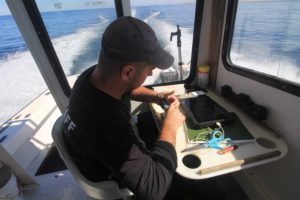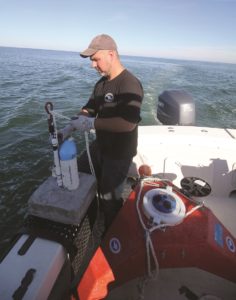PROVINCETOWN — The presence of great white sharks on the Outer Cape’s shores may not be the shocking news it used to be, but just how much of the time these fish are patrolling the waters close to shore during summer and early fall might be.
Bryan Legare, a doctoral intern who is manager of the shark ecology program at the Center for Coastal Studies here, has been tracking shark movements and behaviors at Head of the Meadow in Truro since 2019 and at Nauset Beach in Orleans since 2020. He outlined his preliminary conclusions for the Barnstable County Assembly of Delegates on March 2.
Based on three years of data, Legare said, great white sharks have been detected in near-shore waters at Head of the Meadow during one hour of every two-hour period between July Fourth and Labor Day. During the week of Aug. 9, 2020, they were detected at Head of the Meadow during 165 hours of the 168-hour period studied.

When his tracking program expanded to Nauset Beach two years ago, the frequency of detection was a bit lower there in the first year. But by last summer, sharks were being detected at the same rate at Nauset Beach as they were at Head of the Meadow.
Piggybacking on state shark researcher Greg Skomal’s tagging program, Legare said he uses a dense array of acoustic receivers that pick up the presence of tagged sharks and can closely pinpoint their movements.
“There are also untagged sharks in these waters,” Legare said. “The point of this is not to be alarming, but to show these animals are in the near-shore environment. Even if we can’t see them from the sky or from land, they are present.”
Legare has looked at shark behavior in relation to tide, time of day, and turbidity of the water. His preliminary findings suggest sharks are more likely to be present during high tide than mid-tide, but still show up in decent numbers at low tide. “What this tells me is they are probably responding to the currents, but again, that’s a preliminary assumption at this point,” Legare said.
The data have shown white sharks tend to hug the bottom, whether the water is nine feet deep or 30. In greater depths or turbid waters, which are common on the Outer Cape, they can go undetected by both spotter planes and drones.
Not surprisingly, Legare said the sharks are often found near heavy populations of seals, cruising back and forth along the inner bar.
“You can clearly see that the density is highest near the seal haul-out — where seals come ashore in significant numbers to rest — and they spend the majority of time there,” he said. The advice that people not swim near seals “is a strong recommendation,” he said.
While Atlantic white sharks are present throughout the day, Legare said they seem to favor low-light conditions, something he plans to study further because it could influence the effectiveness of technologies such as drones for spotting sharks.
This summer, Legare will gather data at three more Outer Cape locations — Marconi and Newcomb Hollow beaches in Wellfleet and Herring Cove in Provincetown — thanks to funding from the National Seashore.
While it is rare for a great white shark to bite a human, sharks have bitten people three times in the waters off Truro and Wellfleet since 2012, according to the Cape Cod National Seashore. In 2018, a boogie-boarder at Newcomb Hollow died, the first shark-bite fatality on the Atlantic coast since 1936.

Following Legare’s presentation, John Lipman, past deputy director of the Cape Cod Commission and an Orleans resident, asked about the use of real-time monitoring to alert the public to the numbers and locations of sharks. “My concern is that we’re not doing enough fast enough,” he said. “I worry, if we don’t do more, we’re going to have another shark attack.”
Heather Doyle, leader of Cape Cod Ocean Community, an organization that advocates using technology to prevent shark attacks, argued that spotting sharks from the sky can be done and is “super tactical and available now.”
Legare, however, had noted in his presentation that there are limitations to spotting sharks from planes or drones. “If they are 25 feet down in a turbid water environment, we’re not going to be able to see them from above,” he said.
Wellfleet resident Pat DeFrancesco, a board member of Cape Cod Ocean Community, said, “I strongly feel we need to go back in time and restore the beaches to the safe and carefree environment that they were for my children growing up on the Cape.”
In a phone interview, Seashore Supt. Brian Carlstrom said that the Park has installed call boxes at all six of the backshore beaches it manages. Meanwhile, his agency’s approach to safety emphasizes education. Lifeguards are receiving more training, he said, and the public is being informed about “shark smart principles,” that is, awareness about how humans can reduce risk when entering the sharks’ habitat.
“We are doing everything we can,” Carlstrom said.



